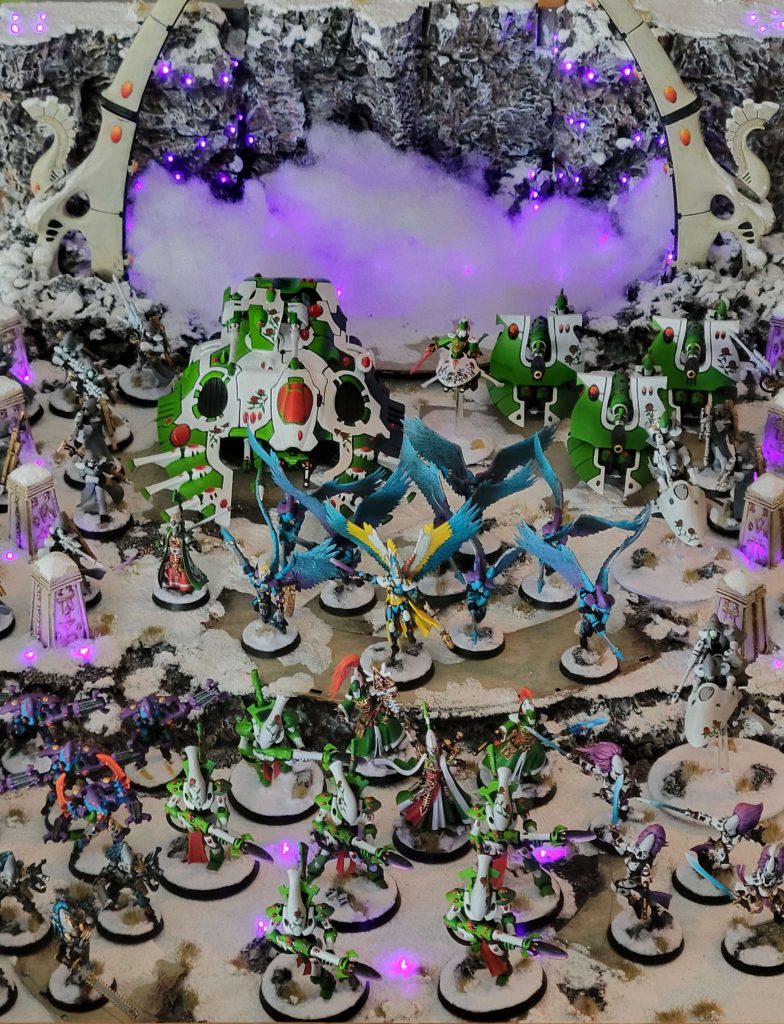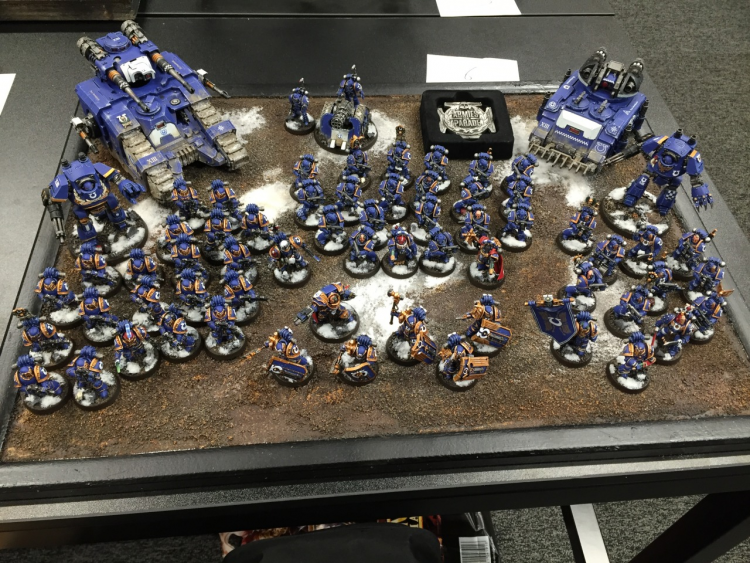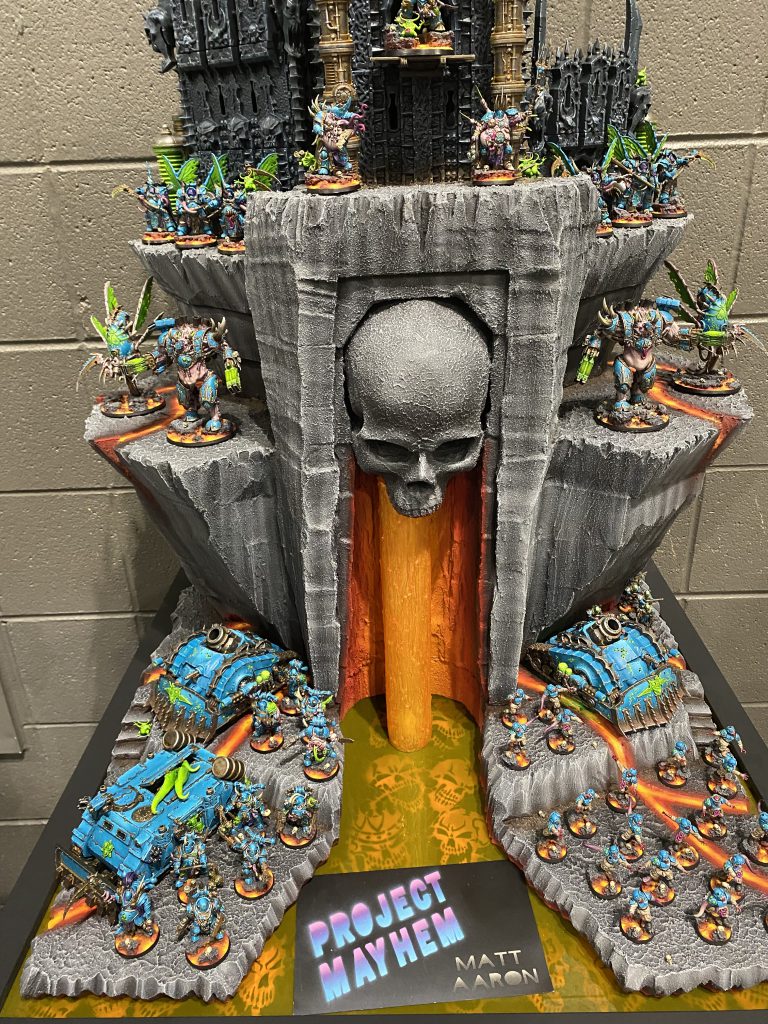One of the core elements of Warhammer 40,000 is the aesthetic that goes with the game and its models – the lore, the narrative feel, the artistry in all its forms. Your paint scheme, your basing, and the little details and flourishes you provide all lend themselves to a sense of theme, and more personally, accomplishment. Usually we think of these things separate from competitive play, not exclusive, but the pursuit of excellence is not mutually dependent on the other.
Most tournaments, with rare exception, adhere to some minimum standard of painting and basing requirements for eligibility but encourage more. However, we generally acknowledge that individual skill or the lack thereof in painting and modelling should not preclude players from participating in games, and as a result, the minimum requirements are set as to be easily achieved with a minimum of hobby talent or skill. Games Workshop itself has defined requirements for what constitutes minimum standards and many tournaments have taken to adopting that standard for their own. However, an additional requirement at many events, particularly American, is the inclusion of display boards in judging rubrics.
As a recognized expert in the study of display boards, I’ll discuss the merits or lack thereof for their inclusion in the competitive space. As we do so, I will need to provide a clear definition for the use of the term “hobby” which is commonly appropriated as a stand-in for painting, basing, etc. However, the definition of the word according to the Oxford dictionary is, “an activity done regularly in one’s leisure time for pleasure.” This is an important definition as it is inclusive of not just the modelling, painting, and basing components of the Warhammer 40,000 hobby, but also the playing of the game as an equal and individual element. There is no intrinsic link or requirement for one or the other – they are both, categorically, hobby. For our discussion we will maintain this overarching idea of hobby as inclusive of all facets of the Warhammer 40,000 universe.
Display Boards Are Cool
First off, display boards are cool as hell and are a lot of fun to make. They essentially serve to turn your whole army into a diorama and extends the theme that you’ve created in modelling, painting, and basing your army to a more encompassing narrative. I have built several boards over the years and have even created a step-by-step on my most recent project. They’re a refreshing change of pace from what can sometimes be a slog through a painting backlog or rushing to finish a unit for the next big event. Mostly, display boards are an opportunity to exercise a completely different skill set than the typical grey plastic painting you’d normally do. Envisioning a board; the dimensions, theme, layout, where the army will sit, lights, and other unique/advanced details represents a true hobby challenge. Further, how you’ll engineer it for travel, future changes, or army sizes all make it a monumental undertaking. The practice of building the board and the eventual sense of accomplishment you receive when the final product matches your vision is, in my opinion, unparalleled in the 40k hobby. The ability to show it off, show the army off, and generally present an idealized vision of the artistic side of Warhammer is a true treat at events and in general.
But therein lies the rub, it’s the artistic side. Display boards are purely an artistic component of Warhammer 40k. To my knowledge, there is no clause in any official rules packet or book where a display board is even mentioned. There are no Games Workshop requirements that to play the game of Warhammer 40,000, in whatever variety or method you choose, you will need a display board to continue. Not in their publications and not in their events. I’m adamant that this is a good thing – display boards are your own extension of the Warhammer universe, a way for the player to create their own space within the broader context of Games Workshop’s IP. The company intruding on that space with an official position, even at the lowest level of requirement, would only serve to restrict or cheapen the uniquely individual effort that goes into the planning and creation of a board. The effort for going above and beyond in the artistic side of the hobby loses relative value when it becomes standardized. Nevertheless, it remains true that whether you have a display board or not, there is no correlation to performance in playing the game of Warhammer 40k.
So, what are we to make of competitive events that require or reward their presence?
Competitive Events & Display Boards
The weighting of display boards as a component of either gameplay or painting focused competition is overwhelmingly an American habit. Globally, tournament organizers simply do not commonly consider display boards in their scoring rubrics. The players themselves, outside of the most artistically driven of players, do not go to the same lengths to create or bring beautiful boards to major events. Indeed, in many regions paint scoring is not a fundamental component of an event series.
However, the idea of rewarding players for their artistry is intuitive enough. The dimension of the hobby is equally valid, more common, and moreover, an exceptionally impressive achievement at the highest levels. Indeed, it often attracts different types of players with a different set of interests, abilities, and reasons to partake in the hobby. Normally this is implicitly acknowledged by major events holding entirely separate competitions for gameplay and artistry, facilitating the pursuit of excellence in one or both, but independent of the other. Neither being more valid, both held in high regard by participants.
Display boards, on the other hand, represent a challenge even in this bifurcated structure. Notionally they are an extension of the artistry of the models themselves and seemingly fall into the same camp. However, in practical application display boards introduce a key advantage in terms of player locality that often goes unremarked and unacknowledged. Furthermore, it creates perception advantages over players who are unable to either bring a board or are unable to bring a board of the same quality of construction. I’ll discuss the nature of these advantage and its impacts on local and non-local players.
The Home Field Advantage
Display boards, particularly large or high-quality display boards, do not travel well. Whether you are driving or flying, they take up considerable space and often need to be handled with care. This creates a logistical challenge for players who are travelling to attend from outside of the local area, whether carpooling or flying, space is at a premium and in the latter case can even come at additional costs if checking bags is required. The greater the distance the more acute this problem becomes as you start to factor in the level of total commitment required. For a local player attending a two-day GT event, a 25-minute drive with everything they need is easily accomplished. For an out-of-state player who is not flying, there are additional considerations around costs for hotels, gas, eating out, time off work (paid or unpaid). The cost of bringing a display board, particularly for those who are flying, is just another component on top of it all.
In business strategy and economics, these types of challenges are referred to as “barriers to entry” in which the factors or context of the market/industry/sector raise costs or prevent newcomers from participating in the market/industry/sector, ultimately limiting competition. The same idea applies here on a smaller scale. Each hurdle that a player is forced to overcome to participate in paint judging competitions only serves to reduce the likelihood that they will participate with the same quality of entry, or even participate at all. With fewer participants, or fewer quality participants, those who can participate face a lower level of potential competition than they would have if such barriers did not exist.
Tournament Organizers generally look to grow their events and often laud participants who have made the journey from out of the local area. However, in this particular circumstance they are in fact placing these players at a distinct systemic disadvantage when they include display boards in their competitive rubrics. However, there is actually a second, derivative advantage that is a bit more abstract and deals with the judging itself.
Value Judgements and First Impressions
Humans, by their nature, are not objective creatures and are wholly anchored by their perception and a combination of biases and heuristics. We use tools and metrics to try to implement a sense of objectivity, but even then, what we define as objective is often based on subjective or relative assumptions. Consider, for a moment, that you may be reading this on your phone or at your desk unmoving. You are still, this is your objective truth by any measure you might immediately apply. And yet, you are actually moving, fast. Depending on your relation to the equator, you are travelling at approximately 1,670 kilometers an hour around the central axis of the Earth. Moreover, that Earth is moving at nearly 30 kilometers per second around our sun, which is itself moving at over 200 kilometers per second around the center of our galaxy. Which is itself… the point is that what we perceive as our objective reality is really a subjective view based on things we’re not consciously aware of in any given moment.
Paint judging, like any critical review of artistry, is by its nature subjective. There are certainly objective measures that can be applied, but at the end of the day meaningful criteria will use subjective assessments of subjectively interpreted guidelines from a subjective observer to discern an ordered ranking or overall champion in any painting-focused competition. This is an important component to understand because a painting competition is a value judgement, and the value is based on a judge’s perception and thought processes as they view something, and judges are subject to unconscious heuristics and biases like anyone else. Display boards serve to shortcut a more considered, analytical cognitive process by introducing a highly tailored first impression to a viewer. While there is a great deal of academic study dedicated to the idea of first impressions (particularly as it relates to human-to-human interaction) the short is that an individual will automatically form an impression of something or someone within seconds or less of first seeing, and these impressions are often fraught with error. By the time any judge will get to the point of leaning in and actually reviewing the detailed work of your models, they will have already formed a baseline opinion that will influence them. That’s the power of a well-crafted display board.
The obvious ramification of this is that it is entirely possible for a judge to award high marks to someone with an impressive display, even if their painting itself isn’t quite as impressive. Certainly with experience and the right technical controls (rubric standards) organizers can control for this, but rarely have I seen this as the case due to the difficult nature of objectively defining painting standards. The end result is that players who are able to bring impressive display boards to an event will likely receive an advantage in the judge’s perception just for having it.

How Should We Consider Display Boards in Competition?
Ultimately, any decision to include or exclude display boards from a painting competition is left to the Tournament Organizers who bear the responsibility. However, as I discussed at the outset, display boards are cool as hell. They are fun to see at events and when done well can take an army over the top. And… to be fair, there is a practical reality to including display boards in painting competitions. In an ideal world, display boards would be judged and awarded independent of the army itself, but this introduces a combination of time and cost challenges for organizer’s who may not have the bandwidth, expertise, staff or prize pool to separate out these categories. Personally, I recommend the following:
- Do not include display boards in a painting competition rubric
- If included, maintain a display board as either a separate category altogether, or as an extra element that can only awards ‘bonus’ points towards a first-round cut. Then require finalists to set up their armies in a designated space, absent of any tailored display boards.
Robnote: The recent Games Workshop Narrative event at the US Open Series Finale handled this perfectly, handing out a separate award for “Best Theme,” which included display boards.
The idea here is to reduce or mitigate the disadvantage players may experience by travelling. Local players may feel disappointed at not being able to include a board towards their score, but remember, these are not required or specified elements of the game, and frankly, no player should want to win a painting competition only because they have an arbitrarily included display board and not on the strength of their actual models. The true tragedy would be an amazing army that is well beyond the skill of anyone else in the room but penalized for the lack of an arbitrary included requirement.
At the end of the day, players who are forced to compete at a disadvantage will generally understand this and either choose to not participate (a shame) or participate knowing they are disadvantaged. And that’s no fun for anyone, nor is it a celebration of the hobby. It’s a celebration of access.
Final Thoughts
I can’t close this article without discussing the elephant in the room. Adepticon has recently released their competitive championship event rubric which includes not just a paint requirement that directly impacts gameplay outcomes, but also includes a significant display board component. I say this as someone who fully expects to be well above their standards, but I find this to be an incomprehensible display of poor judgement and suspect it’s a response to last year’s Harlequin players. Armies which otherwise met their tournament play standards, and indeed any tournament standards short of Gibraltar.
For all the reasons cited above, I don’t believe display boards should be included in painting competitions generally, but I understand that for practical reasons this continues to be the case. Adepticon, however, is not a resource or time-strapped event in the same way that smaller, regional events are and don’t have the same practical limitations. They have consciously blurred the line between artistry and gameplay, making one dependent on the other to the point that to qualify for their top-cut of gameplay results, excellence in artistry is required. It will be entirely possible to meet Adepticon’s standard for entry into their Championship event this year, go undefeated and lead the field heading into day two, and be excluded because you failed to meet an additional levy of arbitrary paint requirements. The fact that this is possible is purely absurd. Your army is either good enough to play in the first place or it isn’t.
To be clear, it’s not absurd because pursuit of excellence in both gameplay and artistry at once is a valid criteria, but because the history and expectations that Adepticon has set for this event previously do not align with this requirement, and further, Adepticon does not exist in a vacuum of competitive events. It is a feeder event to Games Workshop finales and more broadly purports to participate in the competitive gameplay circuits. Inevitably, the exclusion of a qualifying player for the top-cut based on paint standards that otherwise allowed them to play round one would be a travesty. It is akin to requiring golden demon entrants to win a tournament game of Warhammer 40,000 first – it’s simply not relevant and doesn’t make sense.
Have any questions or feedback? Drop us a note in the comments below or email us at contact@goonhammer.com.






